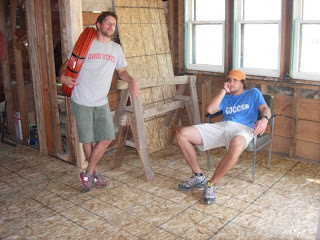by this time all the new subfloors have been put in and so it was on to the heating system...i am going to be putting in a in-floor radiant heat systems as opposed to the more traditional forced air system. a lot of the time these type of heating systems are cast into a concrete floor, but it's also possible to tack the PEX tubing the the underside of the subfloor with aluminum 'fins' (which transfer the heat). i got the system from a company called Radiantec, which does the design as well as the fabrication of all the complex manifold components. It states that it can be installed by a 'reasonably competent handyman', which i assume myself to be, but this, as with everything has been more difficult than expected....big surprise.

don't we look excited to get this underway.

here's tom pulling some of the PEX tubing in the basement. i suppose the most difficult thing about this process is working with such long lengths of tubes. it came from Radiantec in 250' sections, so that's what we generally started with. the other factor is the rigidity of this stuff... it was described by tom as a 'tornado', which really is pretty accurate.
 not all the house has a walkable basement, this part was the least fun...
not all the house has a walkable basement, this part was the least fun...
 so this is pretty much what makes the house live-able. above you can see the domestic hot and cold water manifold on the left. (it's officially called a 'manibloc', i think that's a name brand and it's the black vertical thing with all the ports on both sides) it has an individual port for each fixture in the house instead of having a long run with legs coming off it. this makes it easy to shut of the hot or cold water for a specific outlet and also reduces hot water usage as there is less water in the pipes to be purged when you turn it on. as you can see, some of the hot water tubes have been hooked up, the others (which have not been hooked up) you can see to the right of the manibloc.
so this is pretty much what makes the house live-able. above you can see the domestic hot and cold water manifold on the left. (it's officially called a 'manibloc', i think that's a name brand and it's the black vertical thing with all the ports on both sides) it has an individual port for each fixture in the house instead of having a long run with legs coming off it. this makes it easy to shut of the hot or cold water for a specific outlet and also reduces hot water usage as there is less water in the pipes to be purged when you turn it on. as you can see, some of the hot water tubes have been hooked up, the others (which have not been hooked up) you can see to the right of the manibloc. this is the heat system. and it seems to be working quite well as of right now. its an in-floor radiant heat system, meaning that there is a ton (maybe 3000 ft.) of the PEX plastic tubing running underneath the floor which you run hot water through to heat the floor. the floor then heats up and is essentially the radiator for the entire house....it feels good on your feet. i suppose another interesting point is that the water heater you see on the left is efficient enough to heat my house and provide my domestic hot water. its called a Bradford White combi-core and is supposed to be something like 92% efficient. not too bad. now i just need to get a heat exchanger.... at least when i have an extra grand or so laying around, so not too soon.
this is the heat system. and it seems to be working quite well as of right now. its an in-floor radiant heat system, meaning that there is a ton (maybe 3000 ft.) of the PEX plastic tubing running underneath the floor which you run hot water through to heat the floor. the floor then heats up and is essentially the radiator for the entire house....it feels good on your feet. i suppose another interesting point is that the water heater you see on the left is efficient enough to heat my house and provide my domestic hot water. its called a Bradford White combi-core and is supposed to be something like 92% efficient. not too bad. now i just need to get a heat exchanger.... at least when i have an extra grand or so laying around, so not too soon.





















